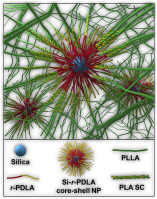当前位置:
X-MOL 学术
›
Compos. Sci. Technol.
›
论文详情
Our official English website, www.x-mol.net, welcomes your
feedback! (Note: you will need to create a separate account there.)
Biodegradable silica rubber core-shell nanoparticles and their stereocomplex for efficient PLA toughening
Composites Science and Technology ( IF 8.3 ) Pub Date : 2018-05-01 , DOI: 10.1016/j.compscitech.2018.02.026 Zibiao Li , Joseph K. Muiruri , Warintorn Thitsartarn , Xing Zhang , Beng Hoon Tan , Chaobin He
Composites Science and Technology ( IF 8.3 ) Pub Date : 2018-05-01 , DOI: 10.1016/j.compscitech.2018.02.026 Zibiao Li , Joseph K. Muiruri , Warintorn Thitsartarn , Xing Zhang , Beng Hoon Tan , Chaobin He

|
Abstract In the effort to overcome the shortcomings such as brittleness and poor mechanical stability, and increase the competitive edge of renewable poly(lactic acid) PLA over conventional petroleum-based thermoplastics, silica rubber core-shell nanoparticles for effective PLA toughening were successfully synthesized by sequential ring opening polymerization (ROP). The core-shell structure was designed with silica as inner core, P(CL-mLA) as ‘rubber’ middle layer and terminal PDLA chains (SiO2-r-PDLA), to facilitate the stereocomplex formation with PLLA matrix for enhanced interface control. The PLLA/SiO2-r-PDLA nanocomposites were fabricated through solution blending-injection molding process. Nuclear magnetic resonance (1H NMR and 13C NMR) results confirmed the presence of grafted ’rubber’ and PDLA chains from the surface of silica particle. In addition, PLLA/SiO2-r-PDLA nanocomposites showed tremendous improvement in thermal and mechanical properties using differential scanning calorimetry (DSC) and tensile testing, respectively. Besides the formation of stereocomplex in the nanocomposites, a detailed study on the melt stability of these stereocomplex nanocomposites revealed a ‘memorized’ stereocomplex behavior, i.e., having the ability to perfectly reassemble after re-crystallization from melt (melt memory effect), when rubber segment is present. Finally, structure-deformation mechanisms were studied using scanning electron microscopy (SEM) and small angle x-ray scattering (SAXS). From SAXS, crazing was clearly observed whereas SEM revealed fibrillated structures. Thus, crazing and fibrillation are the key deformation mechanisms in PLLA/SiO2-r-PDLA system. The exciting new fillers could open up new horizons for PLA advanced composites applications.
中文翻译:

可生物降解的二氧化硅橡胶核壳纳米粒子及其立体络合物可有效增韧 PLA
摘要 为了克服脆性和机械稳定性差等缺点,并提高可再生聚(乳酸)PLA 相对于传统石油基热塑性塑料的竞争优势,成功合成了用于有效增韧 PLA 的硅橡胶核壳纳米粒子。顺序开环聚合 (ROP)。核壳结构的设计以二氧化硅为内核,P(CL-mLA)作为“橡胶”中间层和末端 PDLA 链(SiO2-r-PDLA),以促进与 PLLA 基质的立体络合物形成,以增强界面控制。PLLA/SiO2-r-PDLA 纳米复合材料是通过溶液共混-注射成型工艺制备的。核磁共振(1H NMR 和 13C NMR)结果证实存在来自二氧化硅颗粒表面的接枝“橡胶”和 PDLA 链。此外,使用差示扫描量热法 (DSC) 和拉伸测试,PLLA/SiO2-r-PDLA 纳米复合材料分别显示出热性能和机械性能的巨大改进。除了在纳米复合材料中形成立体复合物外,对这些立体复合物纳米复合材料的熔体稳定性的详细研究揭示了一种“记忆”立体复合物行为,即在从熔体中重结晶后具有完美重新组装的能力(熔体记忆效应),当橡胶段存在。最后,使用扫描电子显微镜 (SEM) 和小角 X 射线散射 (SAXS) 研究了结构变形机制。从 SAXS 可以清楚地观察到裂纹,而 SEM 则显示原纤维结构。因此,裂纹和纤维化是 PLLA/SiO2-r-PDLA 系统中的关键变形机制。
更新日期:2018-05-01
中文翻译:

可生物降解的二氧化硅橡胶核壳纳米粒子及其立体络合物可有效增韧 PLA
摘要 为了克服脆性和机械稳定性差等缺点,并提高可再生聚(乳酸)PLA 相对于传统石油基热塑性塑料的竞争优势,成功合成了用于有效增韧 PLA 的硅橡胶核壳纳米粒子。顺序开环聚合 (ROP)。核壳结构的设计以二氧化硅为内核,P(CL-mLA)作为“橡胶”中间层和末端 PDLA 链(SiO2-r-PDLA),以促进与 PLLA 基质的立体络合物形成,以增强界面控制。PLLA/SiO2-r-PDLA 纳米复合材料是通过溶液共混-注射成型工艺制备的。核磁共振(1H NMR 和 13C NMR)结果证实存在来自二氧化硅颗粒表面的接枝“橡胶”和 PDLA 链。此外,使用差示扫描量热法 (DSC) 和拉伸测试,PLLA/SiO2-r-PDLA 纳米复合材料分别显示出热性能和机械性能的巨大改进。除了在纳米复合材料中形成立体复合物外,对这些立体复合物纳米复合材料的熔体稳定性的详细研究揭示了一种“记忆”立体复合物行为,即在从熔体中重结晶后具有完美重新组装的能力(熔体记忆效应),当橡胶段存在。最后,使用扫描电子显微镜 (SEM) 和小角 X 射线散射 (SAXS) 研究了结构变形机制。从 SAXS 可以清楚地观察到裂纹,而 SEM 则显示原纤维结构。因此,裂纹和纤维化是 PLLA/SiO2-r-PDLA 系统中的关键变形机制。











































 京公网安备 11010802027423号
京公网安备 11010802027423号